Of all the botanic gardens of Victoria, Hamilton’s has kept perhaps the most vintage aspects from its superb entrance gates, through its fountain, rotunda and trees commemorating big names of our past
My experience at the gardens
I loved Hamilton Botanic Gardens as soon as I walked through the beautiful yellow iron gates at the entrance near where I parked my car, on this bright but chilly winter’s morning. It has the perfect combination of retaining vintage features that show its past, while modernising where needed. It’s just the ideal entry for Vintage Victoria.
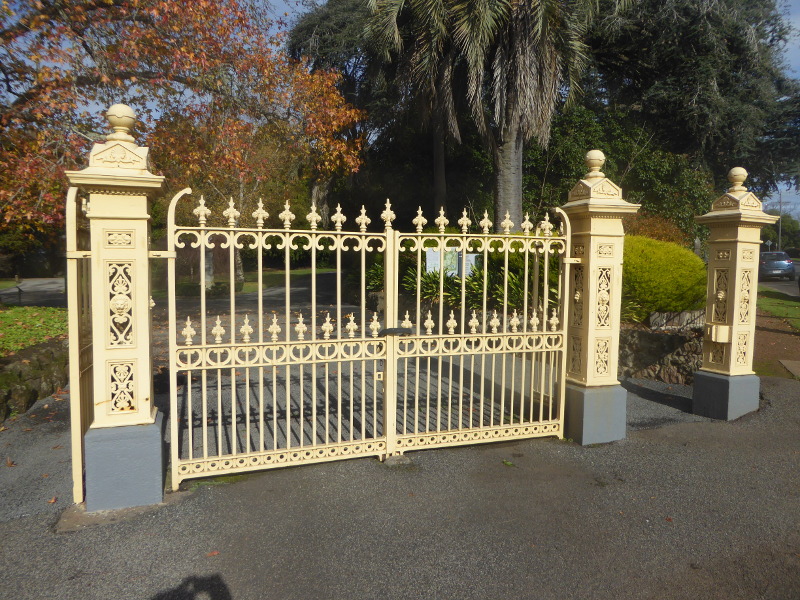
Even the entrance gates are somehow special. There are two sets of gates like these, both installed over 100 years ago so definitely vintage, but unlike the impressive ironwork at some other botanic gardens in Victoria, both these sets of gates were made by Victorian firms rather than being shipped over from the UK.
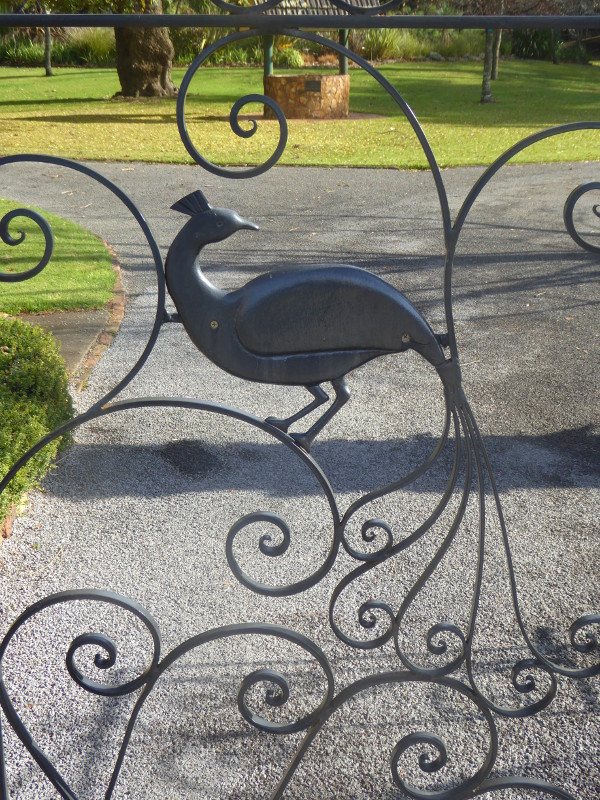
And then round the far side of the Gardens are these peacock gates, more modern, but almost ‘vintage’, as they were installed in 1967 as a memorial to a local resident.
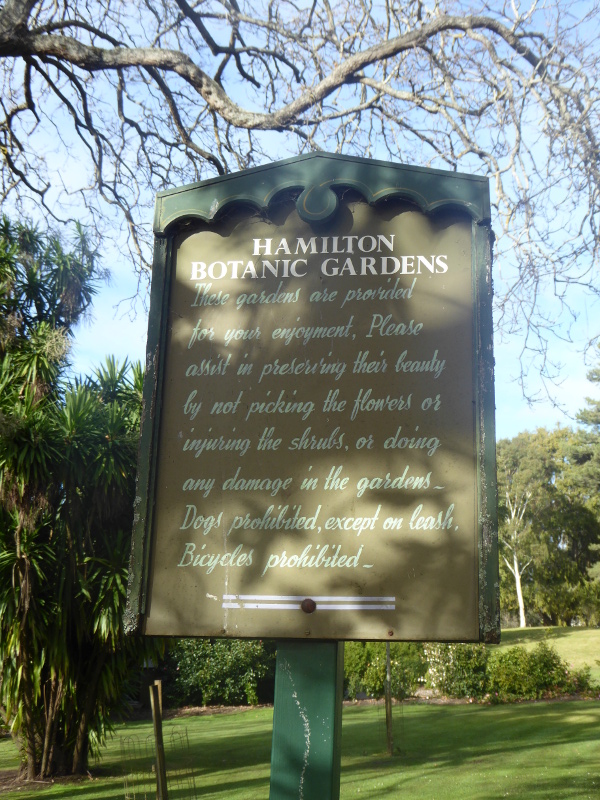
By each entry point is this rather nice old signage about the gardens.
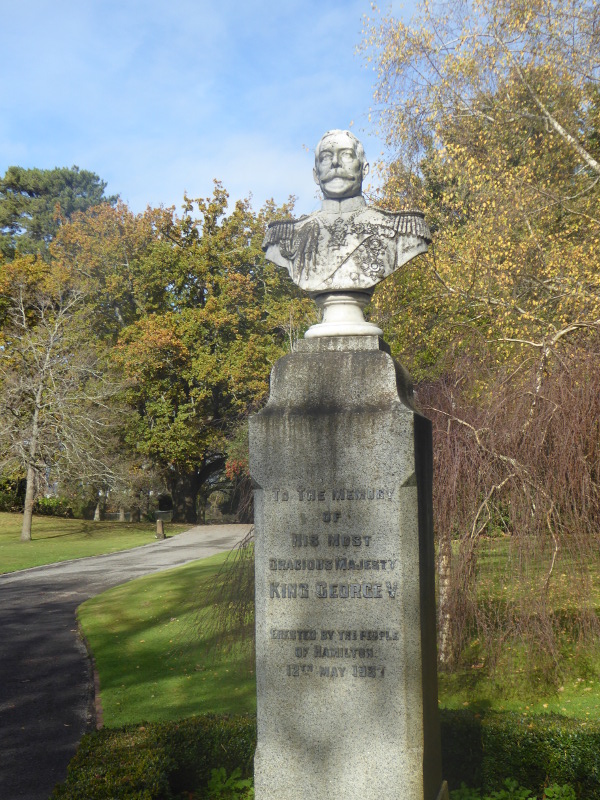
And then right in front of the gates I entered by, stands this statue to George V, erected in 1936 or 7 as a memorial to the king who had seen the country through World War 1.
From the map and information board on the gardens, I saw how Mr Guilfoyle, the Melbourne curator, had been involved in the design of the Hamilton Gardens – I actually knew that from the fascinating press clippings I had found on the Gardens’ difficult first few years before the decision was taken to get help from Guilfoyle. But it’s thanks to him that the Gardens have the look they do today.
A short way up the path on the right stands the rotunda. I think this might be a 1920s vintage, installed about the time of Nellie Melba’s visit, though I only read about her planting of a tree in the gardens after my visit, so I have no idea if it survived to this day?
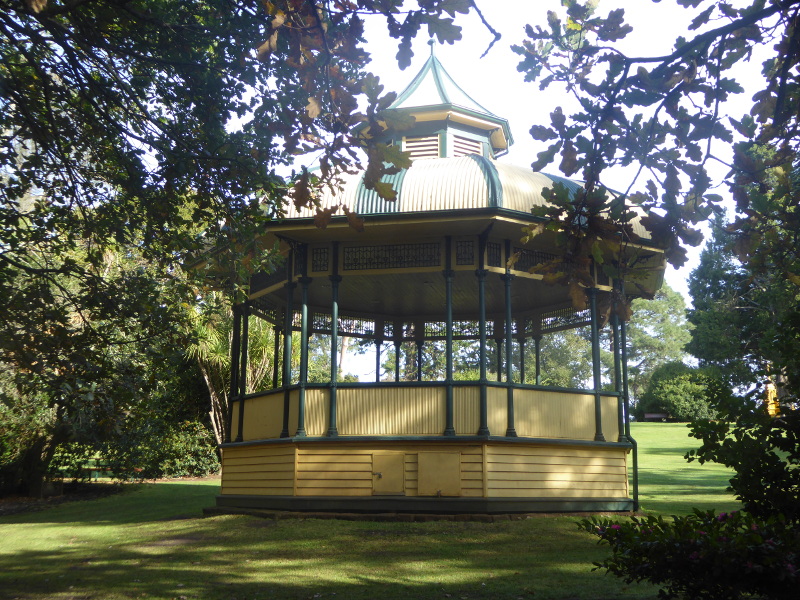
The rotunda is one of many original features that are still to be seen in Hamilton Botanic Gardens.
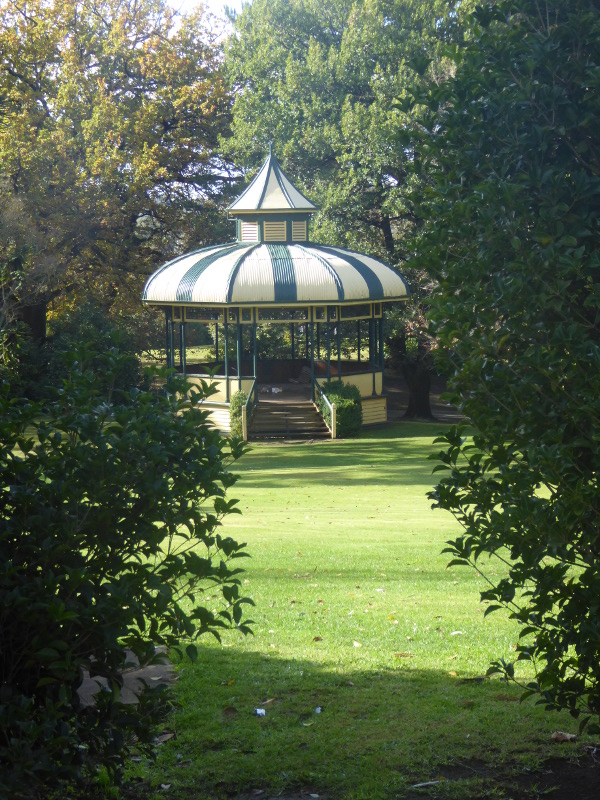
The old curator’s cottage is still at the top end of the Gardens. I think it might have been moved there from another position, and actually looking at the dates, it looks as if the longest-serving curator (Mr Hughan) might have had to oversee the move himself – I wonder how disruptive that was to family life at the time (and for all the beautiful signage and information around Hamilton Gardens, I thought it was a shame not to find anything referring to this man who looked after the gardens from 1903 to 1945).
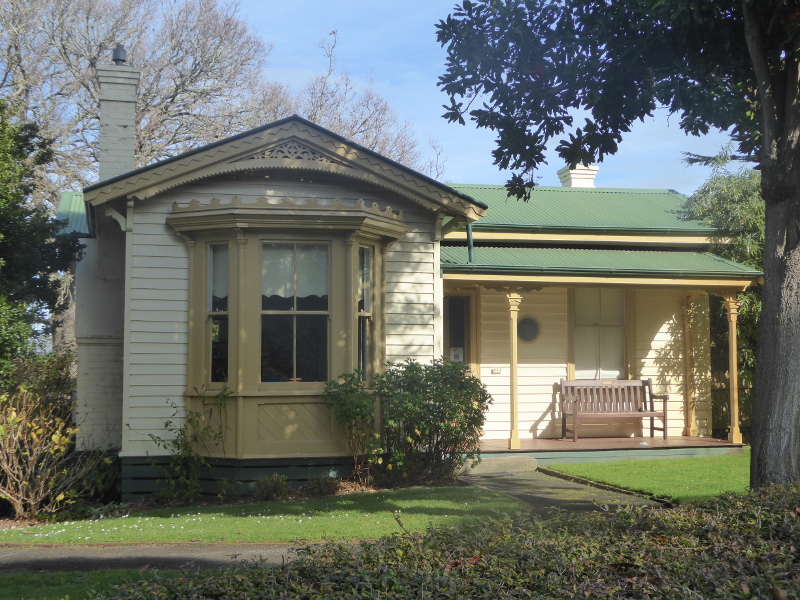
The Thompson Fountain is also a stand-out feature of the Gardens. Another 1890s feature, this has fantastic creatures and carvings spouting water all through the year. It was a big hit with passing kids even now over 100 years on.
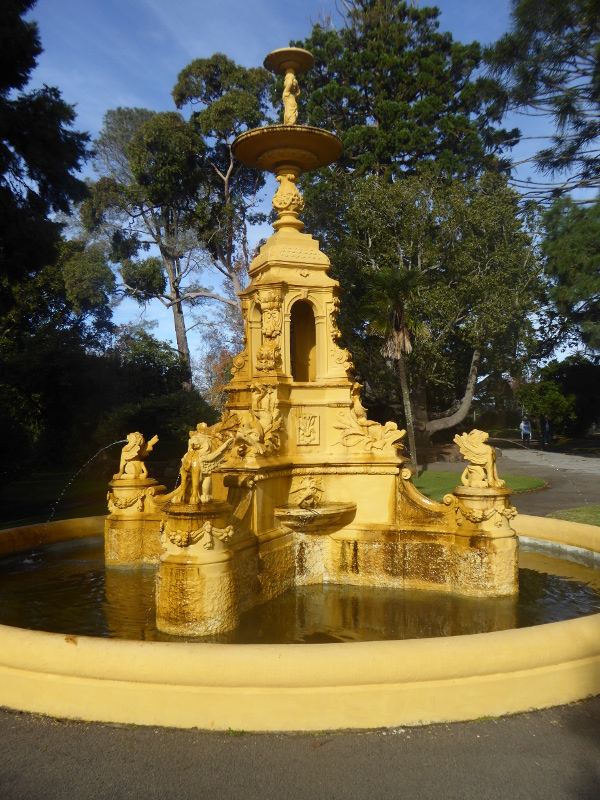
There is a small plaque mentioning the name of the man in whose memory it was installed (Thompson), but again it would have been nice to know more about the fountain, and about Mr Thompson…

It was the fashion once upon a time to have cannons like these on display in significant spots around towns. I believe this cannon in Hamilton’s botanic gardens might at first have had pride of place where the George V statue is today, by the entrance gates (it also might have been a different cannon – can anyone confirm?). But these days it is tucked away on one of the paths sloping dow through the middle of the gardens.

What I liked, though is how the local technical college students were roped in to making a new gun carriage for this cannon, in the original style, so making another connection between past and present, which is so much what Vintage Victoria is all about.
The aviary in the gardens is another example of trends I like to see in vintage places. Botanic Gardens, when they became places of leisure rather than science, began to include small menageries or zoos in many of them. Hamilton was no exception, with wombats and wallabies, emus and kangaroos all at one time or other having a ‘home’ in the gardens. Various birds were also on display (though I rather liked the story of ‘Jimmy’ making his escape in my stories from history below).
The newly-modernised aviary in Hamilton Botanic Gardens was re-opened only in April 2021, and judging by the frantic excitement of the birds in there today, they all seem happy enough and full of energy. It’s really nice to see.
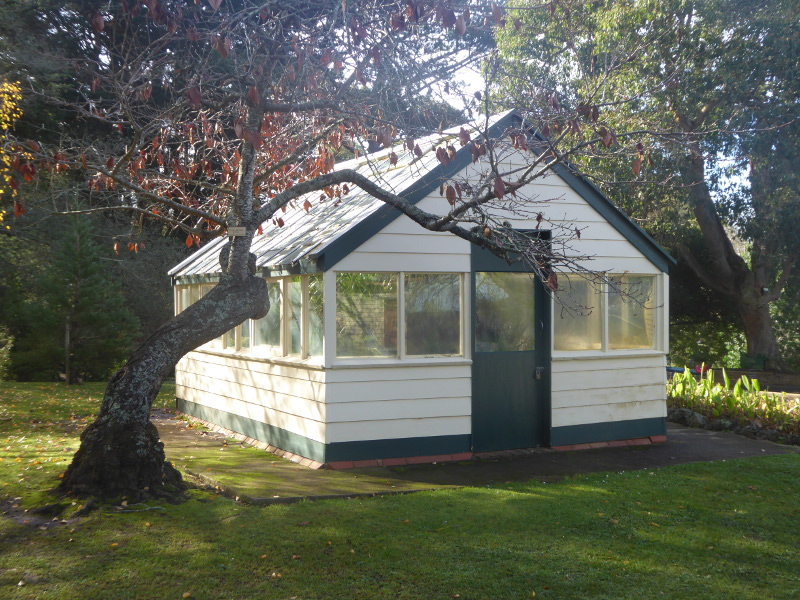
This little glasshouse stands opposite the aviary. It looks nicely vintage but I’m not convinced it is the original glasshouse installed over 100 years ago, and it seems rather smaller than the descriptions I read of that first glasshouse.
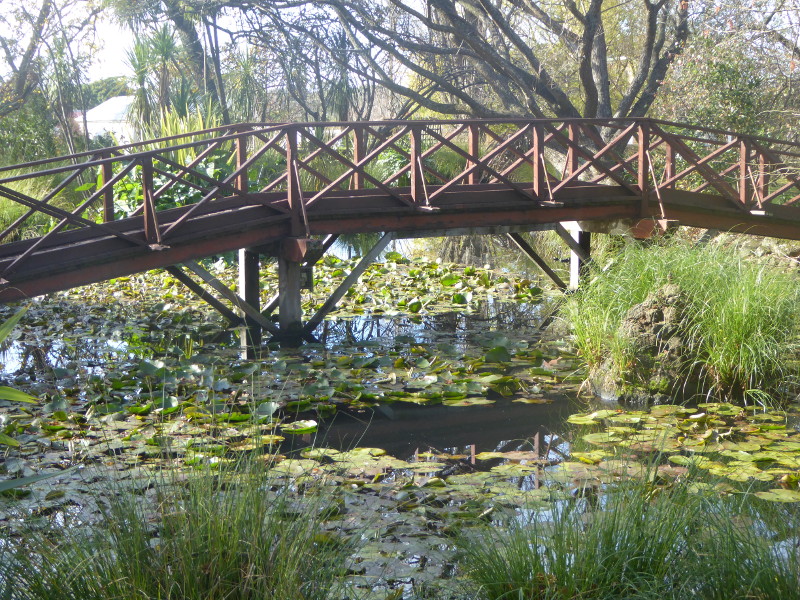
And then back down to the lake and the bridge in the lower part of the gardens. It’s a beautiful spot with lovely lilies which must be stunning in season. The bridge was rebuilt in 1995, but in the style of the 1920s structure. Again, good job done, Hamilton!
With all vintage structures around Hamilton’s gardens, I haven’t even had space to mention the trees yet. There are some absolute beauties.

And I loved looking up at this Bunya Bunya tree, making me almost dizzy, as it reached up so far into the sky.
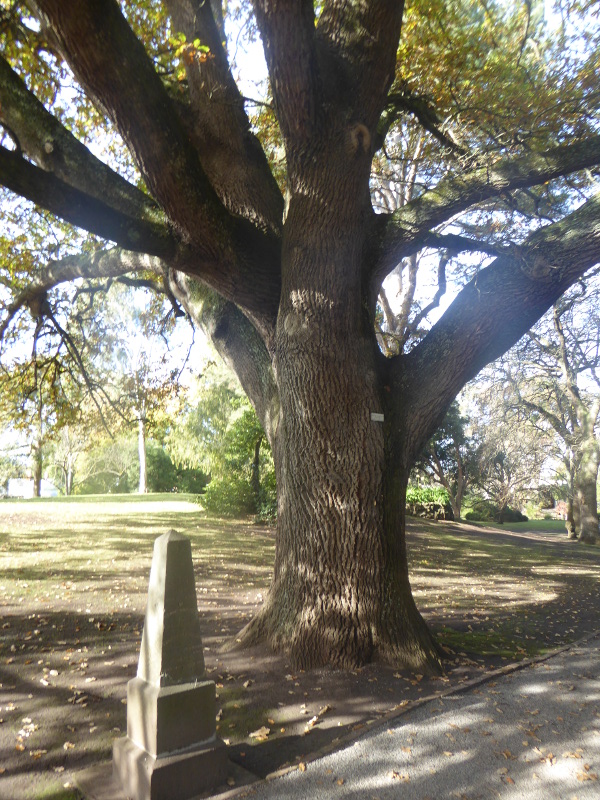
There are quite nice plinths by many of the trees, reminding us of who planted them, or in whose memory (100th and 150th anniversary of the Sabbath Schools (?), in memory of Edward VII, but as I said, nothing I could find relating to Nellie Melba – maybe she just wasn’t regal or religious enough for a plaque?).

Winter isn’t a great time for colour in the public gardens. And as often is the case, purple was the dominant colour if I did find some flowers doing their thing.
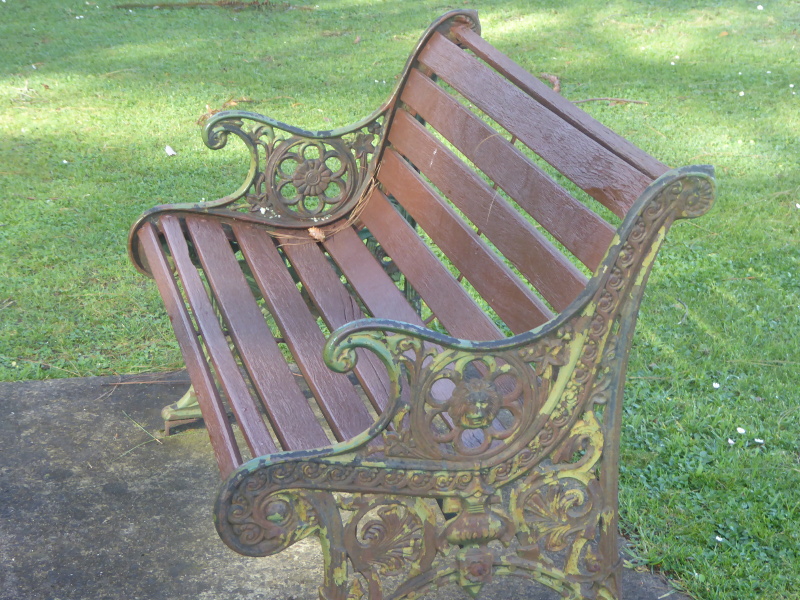
There are benches dotted all around the gardens, not many of them very vintage, except for this fine one.
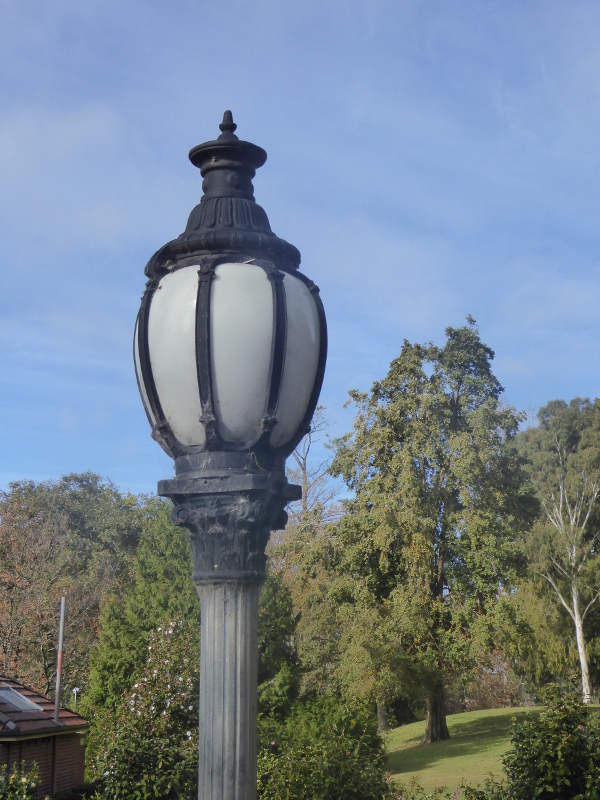
And there are a couple of vintage lamps, suggesting that sometimes the gardens must have been open after dark, too.
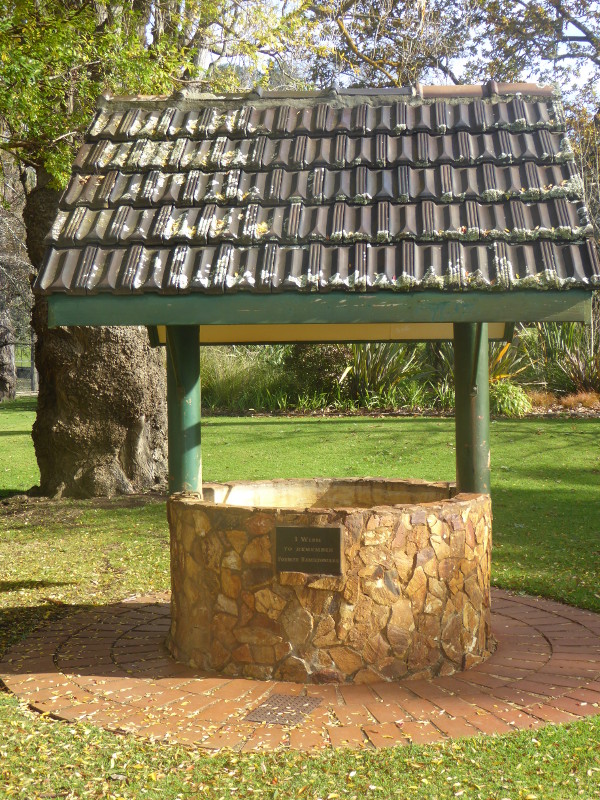
Finally, although not very vintage (I think), I rather liked the wishing well, down by the peacock entry gates. You can throw a coin in here to remember Old Hamiltonians, and that seemed a nice touch, too, forever linking Hamilton to its past.
Practicalities
The gardens are open 24/7.
Plenty of seating dotted around the gardens, and toilets available too
History and stories
Hamilton Botanical Gardens were officially opened at a later date than many others in Victoria. 1870 was the date they were founded, though the first real mention of them in the Trove database came from an advert in 1873 for a gardener to plant and maintain them.
By 1875, it sounds as if there were still no trees in Hamilton’s Botanic Gardens. Shrubs had been planted and were making good progress, according to the local newspaper, but the gardens needed some trees to provide much-needed shade. And even two years after that, in 1877, the Hamilton Spectator was comparing the Gardens unfavourably with Portland’s Botanic Gardens. The Hamilton Botanic Gardens are, the newspaper said, ‘a dreary waste’, barely worthy of the name they have.
In 1880 a black snake was found sleeping under a hayrick in the Botanic Gardens, not the first time one of its kind had been seen in the area, so clearly there was a breeding place somewhere in the Gardens, and the local paper warned readers to watch out if walking through them.
In 1881 the Hamilton Spectator was still not happy at the state of the town’s gardens. “Nothing better than a paddock for nurse maids and their infant charges,” was how one report described the place. The trees that were planted, mostly cypress, had suffered in the drought and few survived. And yet the soil is rich and volcanic, the town’s water supply runs along three sides of the gardens, with no attempt yet made to tap into that for irrigation. But the potential for the gardens was enormous, with its natural amphitheatre and views up to distant mountains.
Finally, In January 1882, the local council took action, picking up a plan laid out for them by Guilfoyle, the head gardener of Melbourne’s Botanic Gardens, building a cottage for the curator, and an ornamental lake with fountain. The Hamilton Spectator was at last enthusiastic about the prospects for the Gardens. The gardens were landscaped over the following months, the lake was installed. By December 1883, the Spectator was only grumbling about the lack of lawns laid out, leaving the danger of snakes still lurking in the long native grasses.
Later in December 1883, the local train station manager donated a black swan to the Gardens. The local paper asked another local citizen to donate a mate so that the swans might stay.
By 1888, sports were being played on the oval inside the botanic gardens. In 1891 the Mayor of Ballarat sent two blackbirds to the Hamilton Botanic Gardens, with a recommendation that they be caged until the gardens became abundant enough in their foodstuff for them to wish to stay – are their descendants still around in 2021?
By 1892 the Gardens were the pride of the town, the curator winning prizes all over the west for his chrysanthemums especially, and other gardens starting to copy ideas from Hamilton. Money was found for a glasshouse, and there were fund-raising activities to have more impressive entrance gates installed. Quite a turn around.
New Year’s Eve 1915 saw a series of short films screened in Hamilton Botanic Gardens, this at a time before cinema had really caught on. Musical accompaniment was provided by Mr and Mrs Palmer. Two years later on New Year’s Eve, more pictures were shown and this time there was what they called a ‘continental concert,’ though I’m not sure what that would have meant…
Also during World War 1, the cannon now tucked away on a shady path in the middle of the Gardens, was on display right by one of the main entrances. Its place was taken by the memorial statue to George V, which still stands by the entrance I came in by in 2021.
Funding became a problem again during the Great War. The Hamilton Spectator, such a critique in the Gardens’ early years, had been converted by the work of two curators: “A large number of women and children, as well as visitors to the town, find the beautiful shade trees and well-kept lawns a pleasant relief from the discomfort occasioned by the intense heat of the sun’s rays.
There were, however, ‘systematic raids’ on the gardens over several days in March 1917. Flowers were damaged as well as being stolen.
The 1926 Girl Guides competition for the district shield were held in Hamilton Botanic Gardens, the results making it as far as the Melbourne papers. Nearly 100 years on, it sounds ridiculous now but among the competitions were bed-making and fire-making, which makes me wonder how many beds they lined up in the gardens, but also just what girl guides got up to and what was their purpose back then?
Nellie Melba visited the Gardens in March 1927, also making the Melbourne news. She planted a tree – a scarlet flowering gum from Western Australia. It was near where the ‘new rotunda was to be placed in the gardens. If it’s still alive, I missed it (and I only found this story after my visit so I wasn’t looking), so I’d love to know if it’s still there, or if anyone remembers it?
A bird the kids called ‘Jimmy’ flew off from the Gardens in 1930 after spending seven years living with the emu and kangaroo kept there. Apparently, what was then known as a ‘native companion’ is now called a brolga. The curator asked if anyone had seen Jimmy, and declared that he was ‘quite friendly’ so could be approached presumably…
What are your experiences at Hamilton Botanic Gardens?
Does anyone just have a good memory they’d like to share about a visit to Hamilton Botanic Gardens? If so, what’s your favourite vintage feature? Or do you prefer the modern developments like the new aviary?
Can anyone fill in with any stories about things that happened in or around Botanic Gardens to bring my history section beyond my last story from the Trove database, which is from as early as 1930?
Other links and writings on the Hamilton Botanic Gardens
The Talking Plants bloggers visited Hamilton Botanic Gardens in December 2019. They have much more botanical knowledge in their posting.
The Victorian Heritage Council entry on Hamilton Botanic Gardens is here.


I’d like to correct some information in your page relating to the entry gates of the Hamilton Botanic Gardens.
French St Gates……There is mention of a contract (Deutscher & Son) for the erection of the garden fence at the Bot. Gardens, meeting of Hamilton Borough Council, Hamilton Spectator 28.8.1908
The Thompson Street gates were made by others as the Deutscher and Son business (operating as Clyde Engineering Works in Lonsdale St Hamilton) only commenced operation in 1904. Out of interest, the business moved to Ballarat in 1923 where it is still operating 100 years later. HF Deutscher was the inventor behind many of the machines built by Deutscher’s including the famous Gem engine.
Perimeter fence….There is mention of a contract (Deutscher & Son) for the erection of the garden fence at the Bot. Gardens, meeting of Hamilton Borough Council, Hamilton Spectator 28.8.1908
Thanks. Great to hear from someone linked to the company (I assume). I have tweaked the text to correct it hopefully.
Thanks Simon, I appreciate your consideration. Yes I am a grandson of HF Deutscher
Looking forward to making some memories with family there afresh. They were awesome back in the day. As a teen I loved seeing the kangaroos and peacocks